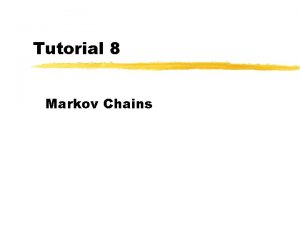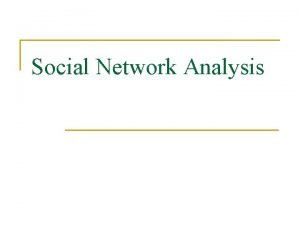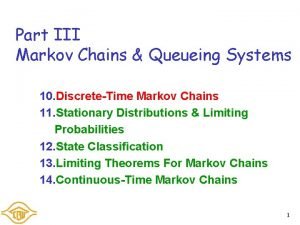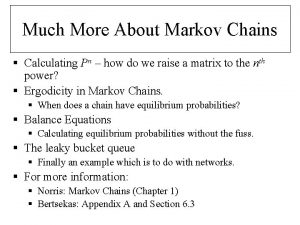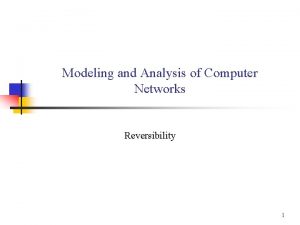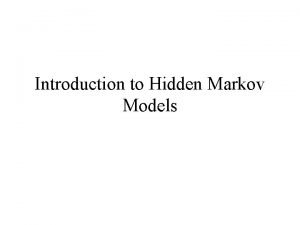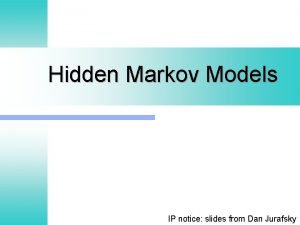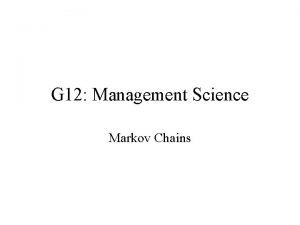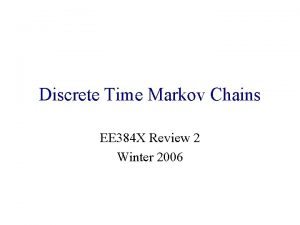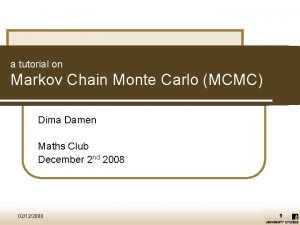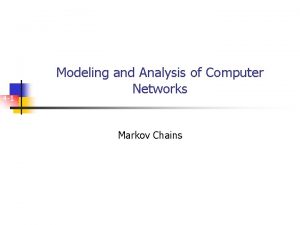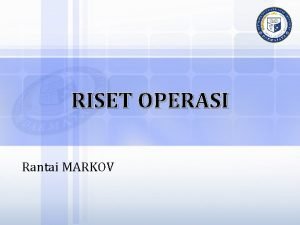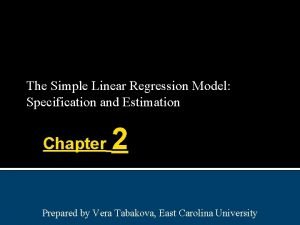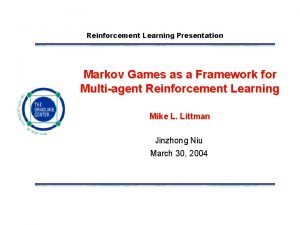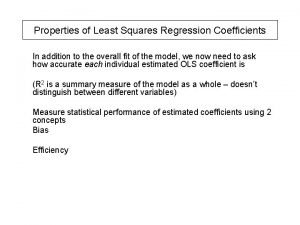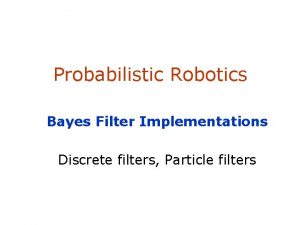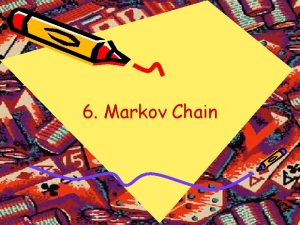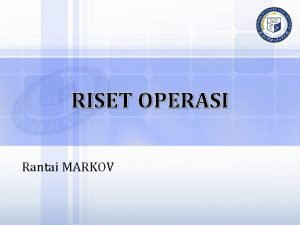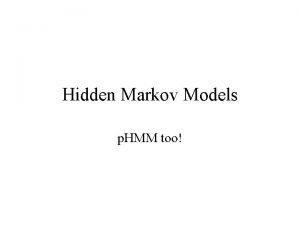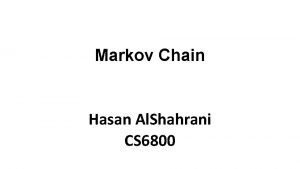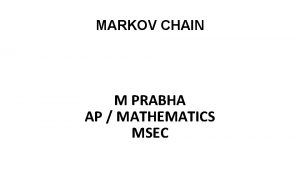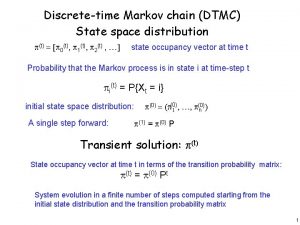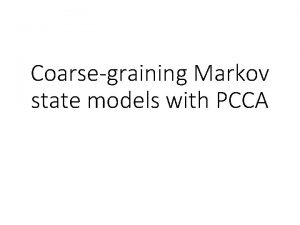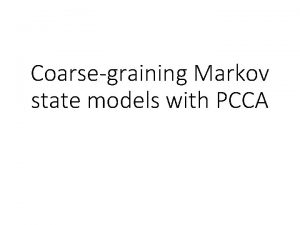6 Markov Chain State Space The state space














![Aperiodic State • A state I is called aperiodic if [Wn]II > 0 for Aperiodic State • A state I is called aperiodic if [Wn]II > 0 for](https://slidetodoc.com/presentation_image/9f10982140239d32a38dc9acee8ca58a/image-15.jpg)













- Slides: 28

6. Markov Chain

State Space • The state space is the set of values a random variable X can take. E. g. : integer 1 to 6 in a dice experiment, or the locations of a random walker, or the coordinates of set of molecules, or spin configurations of the Ising model.

Markov Process • A stochastic process is a sequence of random variables X 0, X 1, …, Xn, … • The process is characterized by the joint probability distribution P(X 0, X 1, …) • If P(Xn+1|X 0, X 1, …, Xn) = P(Xn+1|Xn) then it is a Markov process.

Markov Chain • A Markov chain is completely characterized by an initial probability distribution P 0(X 0), and the transition matrix W(Xn->Xn+1) = P(Xn+1|Xn). • Thus, the probability that a sequence of X 0=a, X 1=b, …, Xn= n appears, is P 0(a)W(a->b)W(b->c) … W(. . ->n).

Properties of Transition Matrix • Since W(x->y) = P(y|x) is a conditional probability, we must have W(x->y) ≥ 0. • Probability of going anywhere is 1, so ∑y W(x -> Y) = 1.

Evolution • Given the current distribution, Pn(X), the distribution at the next step, n +1, is obtained from • Pn+1(Y) = ∑x Pn(X) W( X -> Y) • In matrix form, this is Pn+1 = Pn W.

Chapman-Kolmogorov Equation • We note that the conditional probability of state after k step is P(Xk=b|X 0=a) = [Wk]ab. We have which, in matrix notation, is Wk+s=Wk Ws.

Probability Distribution of States at Step n • Given the probability distribution P 0 initially at n = 0, the distribution at step n is Pn = P 0 Wn (n-th matrix power of W)

Example: Random Walker A drinking walker walks in discrete steps. In each step, he has ½ probability walk to the right, and ½ probability to the left. He doesn’t remember his previous steps.

The Questions • Under what conditions Pn(X) is independent of time (or step) n and initial condition P 0? And approaches a limit P(X)? • Given W(X->X’), compute P(X) • Given P(X), how to construct W(X->X’) ?

Some Definitions: Recurrence and Transience • A state i is recurrent if we visit it infinite number of times when n -> ∞. P(Xn = i for infinitely many n) = 1. • For a transient state j, we visit it only a finite number of times as n -> ∞.

Irreducible • From any state I and any other state J, there is a nonzero probability that one can go from I to J after some n steps. • I. e. , [Wn]IJ > 0, for some n.

Absorbing State • A state, once it is there, can not move to anywhere else. • Closed subset: once it is in the set, there is no escape from the set.

Example 1 2 1/4 1/2 1/2 1/4 5 4 1/4 3 {1, 5} is closed, {3} is closed/absorbing. It is not irreducible.
![Aperiodic State A state I is called aperiodic if WnII 0 for Aperiodic State • A state I is called aperiodic if [Wn]II > 0 for](https://slidetodoc.com/presentation_image/9f10982140239d32a38dc9acee8ca58a/image-15.jpg)
Aperiodic State • A state I is called aperiodic if [Wn]II > 0 for all sufficiently large n. • This means that probability for state I to go back to I after n step for all n > nmax is nonzero.

Invariant or Equilibrium Distribution • If we say that the probability distribution P(x) is invariant with respect to the transition matrix W(x->x ’).

Convergence to Equilibrium • Let W be irreducible and aperiodic, and suppose that W has an invariant distribution p. Then for any initial distribution, P(Xn=j) -> pj, as n -> ∞ for all j. This theorem tell us when do we expect a unique limiting distribution.

Limit Distribution • One also has independent of the initial state i, such that P = P W, [P]j = pj.

Condition for Approaching Equilibrium • The irreducible and aperiodic condition can be combined to mean: • For all state j and k, [Wn]jk > 0 for sufficiently large n. • This is also referred to as ergodic.

Urn Example There are two urns. Urn A has two balls, urn B has three balls. One draws a ball in each and switches them. There are two white balls, and three red balls. What are the states, the transition matrix W, and the equilibrium distribution P?

The Transition Matrix 1 3 1 1/3 2/3 Note that elements of W 2 are all positive. 1/6 2

Eigenvalue Problem • Determine P is an eigenvalue problem: P=PW • The solution is P 1 = 1/10, P 2 = 6/10, P 3 = 3/10. • What is the physical meaning of the above numbers?

Convergence to Equilibrium Distribution • Let P 0 = (1, 0, 0) P 1 = P 0 W = (0, 1, 0) P 2 = P 1 W = P 0 W 2 = (1/6, 1/2, 1/3) P 3 = P 2 W = P 0 W 3 = (1/12, 23/36, 5/18) P 4 = P 3 W = P 0 W 4 = (0. 106, 0. 587, 0. 3) P 5 = P 4 W = P 0 W 5 = (0. 1007, 0. 5986, 0. 3007). . . P 0 W∞ = (0. 1, 0. 6, 0. 3)

Time Reversal • Suppose X 0, X 1, …, XN is a Markov chain with (irreducible) transition matrix W(X->X’) and an equilibrium distribution P(X), what transition probability would result in a timereversed process Y 0 = XN, Y 1=XN-1, …YN=X 0?

Answer • The new WR should be such that P(x) WR(x->x’) = P(x’)W(x’->x) (*) • Original process P(x 0, x 1, . . , x. N) = P(x 0) W(x 0 ->x 1) W(x 1 ->x 2) … W(x. N-1 ->x. N) must be equal to reversed process P(x. N, x. N-1, …, x 0) = P(XN) WR(XN->XN-1) WR(x. N-1 ->XN-2) … WR(x 1 ->x 0). The equation (*) satisfies this.

Reversible Markov Chain • A Markov chain is said reversible if it satisfies detailed balance: P(X) W(X -> Y) = P(Y) W(Y ->X) • Nearly all the Markov chains used in Monte Carlo method satisfy this condition by construction.

An example of a chain that does not satisfy detailed balance 1 2/3 1/3 Equilibrium distribution is P=(1/3, 1/3). 3 1/3 2/3 The reverse chain has transition matrix WR = WT (transpose of W). WR ≠ W. 2

Realization of Samples in Monte Carlo and Markov Chain Theory • A Monte Carlo sampling do not deal with probability P(X) directly, rather the samples, when considered over many realizations, following that distribution. • Monte Carlo generates next sample y from the current x, using the transition probability W(x -> y).
 Transition matrix example
Transition matrix example Absorbing state
Absorbing state Eltonian pyramid
Eltonian pyramid Kpuska
Kpuska Bing
Bing Aperiodic markov chain
Aperiodic markov chain Markov chain natural language processing
Markov chain natural language processing Aperiodic markov chain
Aperiodic markov chain Birth and death process examples
Birth and death process examples Aperiodic markov chain
Aperiodic markov chain Markov analysis
Markov analysis Aperiodic markov chain
Aperiodic markov chain Hidden markov chain
Hidden markov chain Hidden markov chain
Hidden markov chain Aperiodic markov chain
Aperiodic markov chain Aperiodic markov chain
Aperiodic markov chain Transient markov chain
Transient markov chain Mcmc tutorial
Mcmc tutorial Birth death process
Birth death process Operations research and supply chain
Operations research and supply chain Value chain and supply chain difference
Value chain and supply chain difference Pnf patterns
Pnf patterns Gauss markov assumptions
Gauss markov assumptions Markov analysis
Markov analysis Hidden markov model rock paper scissors
Hidden markov model rock paper scissors Mdp example
Mdp example Gauss markov assumptions
Gauss markov assumptions Cov(ui uj)=0
Cov(ui uj)=0 Markov localization
Markov localization
